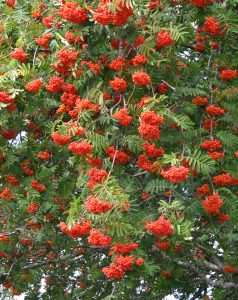 Next time you are in the countryside just stop by a rowan tree and wonder at the uses we make of them. Medicine, food (even more important food for wildlife), timber, symbols, myths and legends and not forgetting the poets. At this time lf the year if you look up into the branches you can get an idea as to whether it will be a bumper year for the rowan berries or not. The berries, in tight clusters, are still green and it is hard to imagine how colourful and attractive they can be such as in the photograph that I took in the Autumn last year. However, the present green clusters can still give an idea of the crop and it looks, as far as the trees I looked at, to be only an average year. This will not make much difference as far as we are concerned but for wildlife it will be different matter. For example the mistle thrushes, often in family groups from local residential birds will have a go at the berries first. These local birds are then followed by the very large numbers of Scandinavian thrushes, redwings and fieldfares. Ironically how many descend on us each Autumn depends on their own rowan trees in their vast forests. If their crop is good their departure may be delayed and some birds may decide not to move at all. When they reach us, if the rowan berry crop is not good or has already been taken, they will just move south or west to Ireland. No less than twelve species of birds are known to take rowan berries as food from starlings to robins and blackcaps to jays.
Next time you are in the countryside just stop by a rowan tree and wonder at the uses we make of them. Medicine, food (even more important food for wildlife), timber, symbols, myths and legends and not forgetting the poets. At this time lf the year if you look up into the branches you can get an idea as to whether it will be a bumper year for the rowan berries or not. The berries, in tight clusters, are still green and it is hard to imagine how colourful and attractive they can be such as in the photograph that I took in the Autumn last year. However, the present green clusters can still give an idea of the crop and it looks, as far as the trees I looked at, to be only an average year. This will not make much difference as far as we are concerned but for wildlife it will be different matter. For example the mistle thrushes, often in family groups from local residential birds will have a go at the berries first. These local birds are then followed by the very large numbers of Scandinavian thrushes, redwings and fieldfares. Ironically how many descend on us each Autumn depends on their own rowan trees in their vast forests. If their crop is good their departure may be delayed and some birds may decide not to move at all. When they reach us, if the rowan berry crop is not good or has already been taken, they will just move south or west to Ireland. No less than twelve species of birds are known to take rowan berries as food from starlings to robins and blackcaps to jays.
It is surprising just how many animals take rowan berries and one, the pine marten, seems to delight in taking and eating large numbers. If a pine marten has been feeding on rowan berries then the droppings will look like the red of them as undigested parts pass through their systems. The heavier male pine martens have been known to clamber along the branches so that the outer parts bends over and when it gets low enough the females reach up and takes the berries. Wood mice will freely take rowan berries and will often store them, albeit briefly, in old birds’ nests for them to come back to later. If the berries are low enough for the badgers to reach up and take them they will and if not they have been known to climb up to six feet off the ground to get this delicacy. Whilst there are no butterflies whose caterpillars feed on rowan leaves there are six moths including the brimstone moth and the orange underwing.
Norman MacCaig, the Highland poet, wrote a poem entitled “Rowan berry” in April 1977 and the five first lines encapsulates the rowan berries.
“I’m at ease in my crimson cluster. / The tree blazes / with clusters of cousins – / my cluster’s the main one and I / am the important berry in it.”
As for the culinary uses for ourselves, I always turn to a little known book “A Country Cup” by Wilma Paterson published in 1980. She lists various recipes including Rowanberry Liqueur and Rowanberry Wine. It is not only recipes she mentions as she say that some believe the rowan would keep the dead from rising so was planted in graveyards, especially in Wales. In the Highlands it was made into coffins. Also ale and beer brewed with the berries is an incomparable drink.
Tags: highland flora
